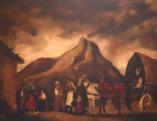2025. November 4. Tuesday
Hamza Collection and Jász Gallery - Jászberény
 |
Address: 5100, Jászberény Gyöngyösi út 7.
Phone number: (57) 503-260, (57) 503-261
E-mail: hamzamuzeum@gmail.com
Opening hours: 01.04.-31.10.:Tue-Sat 10-18
01.11.31.03.: Tue-Sat 10-16 |
The exhibition has closed for visitors.
2007.05.17. - 2007.06.17.
Museum tickets, service costs:
|
Ticket for adults
|
400 HUF
|
|
|
Group ticket for adults
(min. 10 people)
|
200 HUF
|
|
|
Ticket for students
|
200 HUF
|
|
|
Ticket for pensioners
|
200 HUF
|
|
|
Guide
|
500 HUF
|
|
|
Photography
|
500 HUF
|
The painter Rudnay Gyula (Pelsőc, 1878. - Budapest, 1957.) received the Kossuth Prize (1949), was a Merited Artist (1954). He studied with Hollósy Simon from 1895 in Munich and Nagybánya. In the meantime, he did a short field trip to Rome. He moved to Paris in 1903 to continue his studies. He was inspired by Russian realist literature which made him turn towards the life of people and realism. He wanted to make a characteristic national art so he moved to Hódmezővásárhely in 1905. The showed the works he made there along with Pásztor János in Budapest in 1910.

The war experience made him paint fleeing people and dramatic compositions. He worked in Losonc those days. He organized his first one-man exhibition in the Ernst Museum in 1918. From 1919, he spent more time in Bábony painting. He was appointed teacher at the Collage of Fine Arts in 1922. He began to deal with copper engraving in 1922. His works were published in an album in 1923. In 1924 he won gold medals in Vienna and Genova. In 1929 he received the Grand Prix and the silver medal in Barcelona. Many of his works were bought by private collectors from around the world.
He made his large gobelin showing the Parliament of Pusztaszer for the Parliamentary Building in 1926. Those days he was involved in painting fairy tale atmosphere compositions showing Kuruc. In 1947 he established a Colony of Artists in Baja where he lived until 1953. He was influenced by Goya and Munkácsy. His dark tone pictures based on light and dark colors were made in the footsteps of Romanticism.
The artist often visited his sister Rudnay Rózsa, the wife of the priest Halasy Miklós in the 1930's and 1940's in Jászberény. Young artists like Makay József, Vuics István often visited him there and showed their art to him. His professional judgment influenced these artists. Among others Makay József chose the profession after the encouragement of Rudnay. Many Rudnay artworks are held by private collectors living in Jászberény. Dr. Halasy Miklós, an MD from Jászberény took significant part in the reconstruction of the Rudnay Memorial House on the 100th anniversary of the birth of the artist.

The war experience made him paint fleeing people and dramatic compositions. He worked in Losonc those days. He organized his first one-man exhibition in the Ernst Museum in 1918. From 1919, he spent more time in Bábony painting. He was appointed teacher at the Collage of Fine Arts in 1922. He began to deal with copper engraving in 1922. His works were published in an album in 1923. In 1924 he won gold medals in Vienna and Genova. In 1929 he received the Grand Prix and the silver medal in Barcelona. Many of his works were bought by private collectors from around the world.
He made his large gobelin showing the Parliament of Pusztaszer for the Parliamentary Building in 1926. Those days he was involved in painting fairy tale atmosphere compositions showing Kuruc. In 1947 he established a Colony of Artists in Baja where he lived until 1953. He was influenced by Goya and Munkácsy. His dark tone pictures based on light and dark colors were made in the footsteps of Romanticism.
The artist often visited his sister Rudnay Rózsa, the wife of the priest Halasy Miklós in the 1930's and 1940's in Jászberény. Young artists like Makay József, Vuics István often visited him there and showed their art to him. His professional judgment influenced these artists. Among others Makay József chose the profession after the encouragement of Rudnay. Many Rudnay artworks are held by private collectors living in Jászberény. Dr. Halasy Miklós, an MD from Jászberény took significant part in the reconstruction of the Rudnay Memorial House on the 100th anniversary of the birth of the artist.
